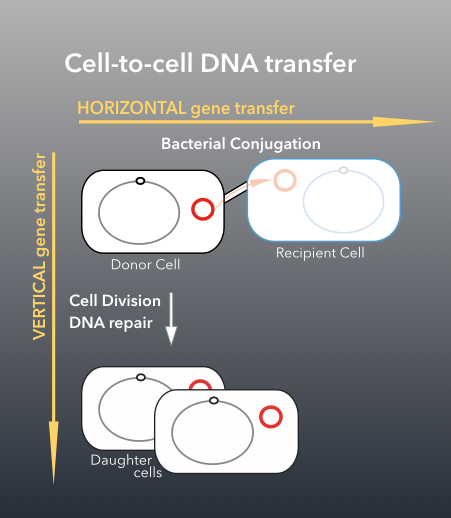RESEARCH INTERESTS
In all living organisms, genetic material is faithfully transmitted from mother to daughter cells over generations. During this vertical gene transfer, the integrity and stability of the transmitted genetic information is maintained by DNA repair mechanisms, mainly by homologous recombination (HR) mediated by RecA/Rad51 conserved protein. Defects in HR lead to genetic instability responsible of genetic diseases and cancers. Bacterial cells can also acquire foreign DNA by horizontal gene transfer. This DNA can come from the environment or from another bacteria and can be integrated to the genome by RecA-dependent recombination. Horizontal gene transfer is the major process involved in the acquisition of new properties such as pathogenesis, multi-drug resistance or adaptation to the environment, and drives the evolution of bacterial genomes. Our lab investigates the intracellular dynamics of the DNA and protein machineries involved in vertical and horizontal gene transfer. We use a combination of molecular genetics and microscopy imaging to observe the real-time dynamics of proteins and DNA in live bacterial cells.

HORIZONTAL TRANSFER
Understanding how a commensal bacterium becomes pathogenic through horizontal gene transfer is a central issues in modern Microbiology. HGT is the major process involved in the acquisition of new properties such as pathogenesis or multi-drug resistance. Pathways of HGT have been extensively described but the mechanistic details of what reactions occur, where and when in vivo, remain unclear. Our experimental strategy enables the direct visualisation of the key steps of DNA conjugation in live Escherichia coli cells. We are interested in describing the propagation of the DNA in the cell population and the intracellular dynamics of the conjugation apparatus during DNA transfer.
VERTICAL TRANSFER
We investigate the real-time dynamics of homologous recombination in live Escherichia coli cells and its interplay with the cell cycle processes. Three aspects are investigated: (i) the structure and function of RecA high-order structures (or bundles) and the way they promote recombination in vivo (ii) the interplay between homologous recombination, chromosome segregation and cell division (iii) the in vivo mechanistic of homologous recombination and the study of the protein factors involved.
